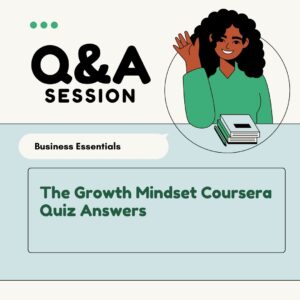Table of Contents
All Weeks Project Execution: Running the Project Quiz Answers
Test your knowledge: Quality management
Q1. As a project manager, you conduct a process to determine which standards of quality are relevant to the project and how to satisfy them. Which quality management concept does this describe?
- Quality control
- Quality assurance
- Quality standards
- Quality planning
Q2. Which quality management concept—often set at the beginning of a project—uses multiple guidelines, such as reliability and usability, to ensure its desired outcome?
- Quality planning
- Quality control
- Quality assurance
- Quality standards
Q3. As a project manager, you and your team monitor project results and delivery to determine if the desired results are being met. If issues are identified, you take corrective action to resolve them. Which quality management concept does this describe?
- Quality planning
- Quality standards
- Quality control
- Quality assurance
Q4. As a project manager, you and your team conduct a review process. Your goal is to evaluate whether the project is moving toward delivering a high-quality service or product and to prevent defects before they occur. Which quality management concept does this describe?
- Quality assurance
- Quality standards
- Quality control
- Quality planning
Test your knowledge: Compile feedback to measure satisfaction
Q1. A project manager should ask open-ended questions when utilizing which of the following three interpersonal skills?
- Tool understanding
- Empathetic listening
- Negotiating
- Trust-building
Q2. When is an optimal time to send out a feedback survey?
- Only after a product or service launches
- Both before and after a product or service launches
- Only before a product or service launches
Q3. What are the main goals of a user acceptance test (UAT)? Select all that apply.
- To confirm that the product, service, or process is working as intended
- To demonstrate that the product, service, or process is behaving in expected ways in real-world scenarios
- To identify issues that need to be addressed before considering the project to be done
- To persuade potential customers to use the new product, service, or process
Q4. As a project manager running a user acceptance test (UAT), you take your users through a sequence of steps to accomplish tasks in your product. What is the term for these steps?
- Acceptance criteria
- Edge cases
- Critical user journey (test cases)
- Feedback survey
Q5. Which of the following are best practices for running an effective UAT? Select all that apply.
- Create test cases for each item being tested.
- Determine user credentials and access permissions the day of the test.
- Write UAT scripts based on user stories.
- Let users decide their own plan for the testing process.
- Define and write down the acceptance criteria.
Test your knowledge: Continuous improvement
Q1. Fill in the blank: _____ is an ongoing effort to improve products or services. It begins with a project manager recognizing processes and tasks that they should create, eliminate, or improve.
- Experimental improvement
- Process improvement
- Control improvement
- Continuous improvement
Q2. As a project manager, you decide to use a continuous improvement framework to help you measure success. The framework you choose has a step that involves conducting performance metrics and data collection to establish baselines. Which framework does this describe?
- PDCA
- KPI
- DMAIC
- UAT
Q3. Which continuous improvement framework does the following scenario represent?
A project manager identifies an ongoing communication issue where a vendor isn’t getting notified about product shipments. To fix the problem, they first plan additional communication strategies. Next, they implement one of their strategies—send an additional email after each shipment. Then, they check to verify that the customer receives the email. Finally, they review the process to fine-tune and ensure continuous improvement.
- DMAIC
- UAT
- PDCA
- KPI
Q4. What’s the main difference between a program and a portfolio?
- A program is a collection of projects, whereas a portfolio is a collection of both projects and programs across an entire organization.
- A program contains better-organized projects than a portfolio.
- A portfolio contains more complex projects than a program.
- A program contains current projects, whereas a portfolio contains previous projects.
Q5. A construction company tests a strategy to reduce costs on a collection of projects. This experiment is part of a long-term business objective. What position would most likely oversee this test across several projects?
- Program manager
- Portfolio manager
- Project manager
- Primary stakeholder
Test your knowledge: Retrospectives
Q1. A project manager sends out an anonymous team survey for feedback after a customer reports they’re not happy with a product feature. Then, the project manager calls a team meeting to discuss the feedback in the survey. During the meeting, the project manager asks the team to use “we” language instead of “you” language. At the end of the meeting, the team discusses what lessons the team will carry into future work.
Which three retrospective best practices are the project manager and team following?
- Use a time-boxed agenda
- Don’t focus only on the negative
- Change perspective
- Be blameless with teammates
Q2. What are the main purposes of a retrospective? Select all that apply.
- Facilitate improved collaboration
- Eliminate all team miscommunications
- Promote positive changes
- Encourage team-building
Q3. What are some typical reasons for holding a retrospective? Select all that apply.
- Reached the end of a Sprint
- Missed deadlines or expectations
- Kicked off a new project
- Delivered a new product
Q4. Fill in the blank: As a project manager, the way you choose to structure your retrospective will depend on _____.
- your customer
- your project scope
- your team and workplace
- your project budget
Weekly challenge 2
Q1. As a project manager, you’re overseeing a product launch. You meet with customers to determine the product’s quality standards. Then, you create processes and documentation necessary to achieve the expected quality. Which quality management concept do these tasks represent?
- Quality control
- Quality planning
- Assurance standards
- Assurance planning
Q2. During which step of the quality management process does a project manager ask questions such as: “How will I determine if the quality measures will lead to project success?” and “What outcome do my customers want at the end of this project?”
- Quality control
- Quality planning
- Quality action
- Quality assurance
Q3. To receive authentic and honest feedback from customers, what strategy should a project manager use?
- Ask for stakeholder feedback and relay it to customers in hopes to close the gap between the customer’s expectation and the project’s needs
- Ask for feedback after the project finishes because customers won’t fully understand the product until it’s complete
- Incentivize customers with a gift card because they’re more likely to respond
- Ask open-ended questions and listen to the customer’s current state versus their desired state
Q4. During a user acceptance test (UAT), the users identify outliers that the original requirements didn’t account for, such as extreme use of the product. What UAT quality control step does this represent?
- Edge cases
- Unknown cases
- Business cases
- User error cases
Q5. Before running a process improvement experiment, a project manager needs to first identify processes to change and leave unchanged. What’s the experiment-related term for the unchanged process?
- Comparable group
- Control group
- Variable group
- Research group
Q6. As a project manager, you have already identified a process-based problem to improve, found its root cause, and implemented a solution. Now, you take the next step: You monitor the new process to ensure the changes are beneficial to the team. Which DMAIC step are you currently applying?
- Improve
- Define
- Control
- Analyze
Q7. As a project manager applying the PDCA process, you’ve already attempted to fix a process that you believe is causing a common customer complaint. As your next step, you compare your results to the goal to determine if you fixed the issue. What PDCA step will you apply?
- Plan
- Do
- Check
- Act
Q8. A project team discovers an efficient process to more quickly develop a product. The program manager implements the idea in several other projects. When the portfolio manager learns that the more efficient process is working across several projects, they recommend it to several programs. This scenario exemplifies which best practice?
- Positive feedback
- Word-of-mouth communication
- Hierarchical communication
- Continuous improvement
Q9. Fill in the blank: The way a project manager decides to structure a retrospective depends on _____.
- team and workplace
- the latest project management trends
- project sponsor preference
- the previous project manager’s agenda
Q10. As a project manager, you hold a retrospective. During the meeting, you give the team an opportunity to discuss risks that materialized: Were there any gaps between the original plan and its execution? Which retrospective step does this represent?
- Next steps
- Future considerations
- Lessons learned
- Action items
Project Execution: Running the Project All weekly Challenges
Project Execution: Running the Project Quiz Answers | Weekly Challenge 1 >>
Project Execution: Running the Project Quiz Answers | Weekly Challenge 2 >>
Project Execution: Running the Project Quiz Answers | Weekly Challenge 3,4,5,6 >>



